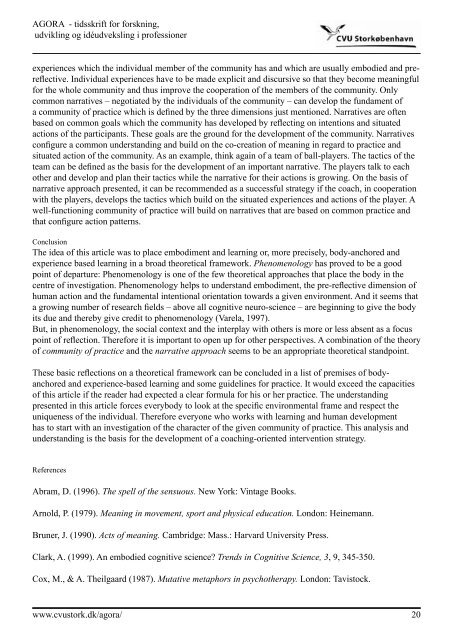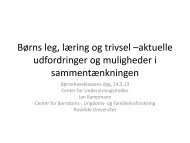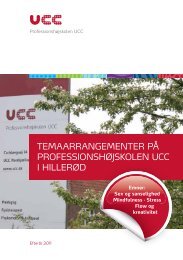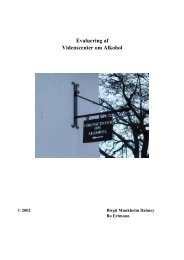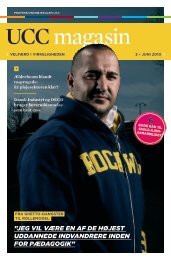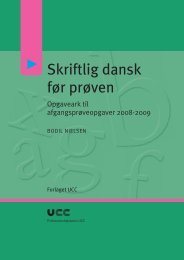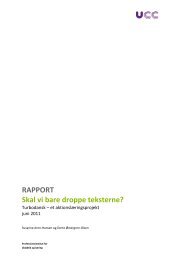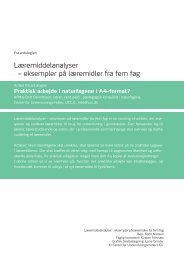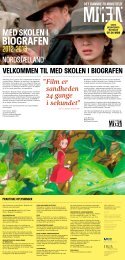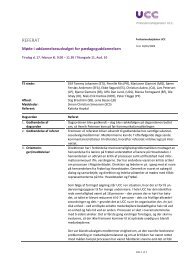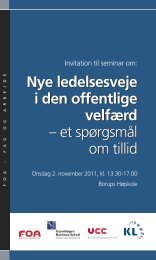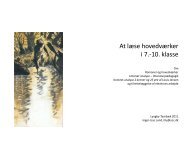AGORA - tidsskrift for forskning, udvikling og idéudveksling i ...
AGORA - tidsskrift for forskning, udvikling og idéudveksling i ...
AGORA - tidsskrift for forskning, udvikling og idéudveksling i ...
You also want an ePaper? Increase the reach of your titles
YUMPU automatically turns print PDFs into web optimized ePapers that Google loves.
<strong>AGORA</strong> - <strong>tidsskrift</strong> <strong>for</strong> <strong>for</strong>skning,<br />
<strong>udvikling</strong> <strong>og</strong> <strong>idéudveksling</strong> i professioner<br />
experiences which the individual member of the community has and which are usually embodied and prereflective.<br />
Individual experiences have to be made explicit and discursive so that they become meaningful<br />
<strong>for</strong> the whole community and thus improve the cooperation of the members of the community. Only<br />
common narratives – negotiated by the individuals of the community – can develop the fundament of<br />
a community of practice which is defined by the three dimensions just mentioned. Narratives are often<br />
based on common goals which the community has developed by reflecting on intentions and situated<br />
actions of the participants. These goals are the ground <strong>for</strong> the development of the community. Narratives<br />
configure a common understanding and build on the co-creation of meaning in regard to practice and<br />
situated action of the community. As an example, think again of a team of ball-players. The tactics of the<br />
team can be defined as the basis <strong>for</strong> the development of an important narrative. The players talk to each<br />
other and develop and plan their tactics while the narrative <strong>for</strong> their actions is growing. On the basis of<br />
narrative approach presented, it can be recommended as a successful strategy if the coach, in cooperation<br />
with the players, develops the tactics which build on the situated experiences and actions of the player. A<br />
well-functioning community of practice will build on narratives that are based on common practice and<br />
that configure action patterns.<br />
Conclusion<br />
The idea of this article was to place embodiment and learning or, more precisely, body-anchored and<br />
experience based learning in a broad theoretical framework. Phenomenol<strong>og</strong>y has proved to be a good<br />
point of departure: Phenomenol<strong>og</strong>y is one of the few theoretical approaches that place the body in the<br />
centre of investigation. Phenomenol<strong>og</strong>y helps to understand embodiment, the pre-reflective dimension of<br />
human action and the fundamental intentional orientation towards a given environment. And it seems that<br />
a growing number of research fields – above all c<strong>og</strong>nitive neuro-science – are beginning to give the body<br />
its due and thereby give credit to phenomenol<strong>og</strong>y (Varela, 1997).<br />
But, in phenomenol<strong>og</strong>y, the social context and the interplay with others is more or less absent as a focus<br />
point of reflection. There<strong>for</strong>e it is important to open up <strong>for</strong> other perspectives. A combination of the theory<br />
of community of practice and the narrative approach seems to be an appropriate theoretical standpoint.<br />
These basic reflections on a theoretical framework can be concluded in a list of premises of bodyanchored<br />
and experience-based learning and some guidelines <strong>for</strong> practice. It would exceed the capacities<br />
of this article if the reader had expected a clear <strong>for</strong>mula <strong>for</strong> his or her practice. The understanding<br />
presented in this article <strong>for</strong>ces everybody to look at the specific environmental frame and respect the<br />
uniqueness of the individual. There<strong>for</strong>e everyone who works with learning and human development<br />
has to start with an investigation of the character of the given community of practice. This analysis and<br />
understanding is the basis <strong>for</strong> the development of a coaching-oriented intervention strategy.<br />
References<br />
Abram, D. (1996). The spell of the sensuous. New York: Vintage Books.<br />
Arnold, P. (1979). Meaning in movement, sport and physical education. London: Heinemann.<br />
Bruner, J. (1990). Acts of meaning. Cambridge: Mass.: Harvard University Press.<br />
Clark, A. (1999). An embodied c<strong>og</strong>nitive science? Trends in C<strong>og</strong>nitive Science, 3, 9, 345-350.<br />
Cox, M., & A. Theilgaard (1987). Mutative metaphors in psychotherapy. London: Tavistock.<br />
www.cvustork.dk/agora/ 20


